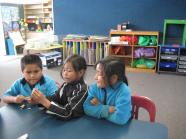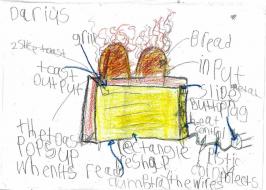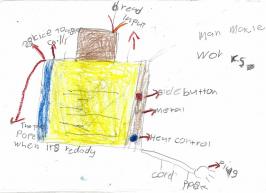Learning about technological systems with junior students
This snapshot describes a teaching strategy that was used to support year 2–3 student understandings of technological knowledge in the technology component of technological systems.
A junior school teacher approached the technological systems component of the technological knowledge strand through a simple is best strategy. By the end of the learning, their students had used simple circuits to develop their understanding of technological systems and developing digital outcomes. The students could confidently discuss concepts such as inputs and outputs.
Keeping it simple
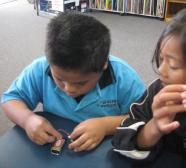
A student working with a battery.
When Ngapoko Ashford approached teaching the technological systems component, it was with a sense of nervousness. She didn’t have any prior knowledge of this component and their students had little or no experience in t – particularly this component.
After professional learning and development and conversations with researcher Moira Patterson from the University of Auckland, Ngapoko developed very successful programmes of learning in which their students used their understandings of systems to create torches. An important factor was keeping it simple – Ngapoko taught the concepts of systems in relation to items that were familiar to their young students.
Exploring aspects of technological systems
Ngapoko says she didn’t have much understanding of technological systems and hadn’t really thought about the concept in an educational sense. She read curriculum content information, but admits to feeling a bit apprehensive about teaching this component.
Ngapoko introduced technological systems through exploring everyday objects that her students could relate to. The students discussed what a technological system is. Then they cut out examples of technological systems from magazines and pasted them into their workbooks. The students then talked about why they thought the images they’d chosen represented systems.
The importance of language
Ngapoko realised that teaching the terminology of technology wasn’t enough and that she needed to use it continuously to keep it alive. From then on, she emphasised the language, using "technology words" when she talked about what the students had covered and repeating things "to fix the language in their heads". She introduced technology to the morning talk, to provide another for students to extend their understanding.
“It took a bit of time to get that into the student's thinking, but they enjoyed bringing items from home and discussing whether it was a system or not. As a result of this, students were going home and talking about technology.”
Throughout the programmes of learning, Ngapoko ensured that the students handled the objects she brought in. “The language of systems is vital, and understanding the terminology was linked to practical activities.”
Learning about different systems
Ngapoko brought in a wind-up mechanism, to demonstrate a common mechanism without the distraction of the toy it came from. The students brainstormed how it worked.
The class worked in groups to consider a selection of objects – a manual egg beater, a battery-powered car, a wind-up ladybird, a wind-up dinosaur, and a wind-up boat. The students played with and discussed each toy, then they produced a group sketch that they annotated to describe how the system worked.
An item from the classroom environment provided another example of a different technological system. Ngapoko showed the students how the parts inside a transparent ballpoint pen work. This was a system they could easily understand.
Exploring a toaster
Ngapoko brought in a toaster and the students made toast as they learnt about another kind of technological system with an outcome. Ngapoko explained the concepts of inputs, outputs, and transformation. As the students made their toast, she asked them about the process of how bread was turned into toast: “What does the system do?” (It turns bread into toast.) “What is the input?” (Electricity and bread.) “What is the output?” (Heat and toast.) “What happens after we push the bread down in the toaster?” (The transformation process starts that turns the bread into toast.)
The students sketched the toaster and annotated their drawings to show what was happening. They also did some procedural writing to describe what was happening when they made the toast. In watching and discussing how the toaster transformed the bread, students learnt that a technological system works by itself. It does not need further human input once the system is initiated. Months later, the students could explain the input, output, and transformation that occur when bread is put in a toaster (technological system). Through discussing this they had learnt that a technological system works independently of further human input.
Making a technological system – a torch
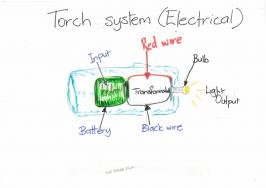
The students continued their learning by developing their own technological system. Initially, Ngapoko considered a jack-in-the-box but, after discussing the various things that have systems in them, the students decided to make torches.
Ngapoko dismantled a torch so that the students could see how all the parts were connected. She discussed electrical and mechanical systems. She compared how the torch worked by itself as a system when it was switched on while the manual egg beater, a mechanical system, required the user to keep winding it as the input to the system.
The students were given circuit kits to experiment with. The kits gave them an insight into how a simple switch and circuit transforms the input (electricity) into the output (light). After this activity, the students each developed a torch. This involved lots of playing – testing the bulb to make sure it worked and testing where the wires should go to make the light up. “This activity got them all going and involved lots of cooperative learning,” Ngapoko says. Some of the students also made a cone from lightweight cardboard to put around their torch.
Assessment for learning
To assess the students’ understanding, Ngapoko set up "bus stops". Groups rotated around each table where they revisited the items they had looked at previously. She assigned students in each group to be writers, drawers, and so on.
Then the students studied each item again and added comments to their original drawing, in some cases working on improving their drawing. Ngapoko says that she could see from the two sets of sketches how much student understanding had improved so she decided to do this repeat activity again in future programmes of learning.
"They got far more out of it the second time around; the conversations were much more informed and the students worked together better. Their conversations were important in showing how much they had learnt – they were more confident and knowledgeable."
As a final activity to help the students think about the concepts underpinning technological systems, Ngapoko set out three items – a manual egg beater and a bowl of cream, a fruit chopper, and a bowl of warm water with liquid soap. The students visited each table to examine the object, work out how it operated, and consider the inputs, outputs, and transformations. The students' understanding of this showed they were achieving at curriculum l 1.
Indicators of Progression: Level 1
Ngapoko says that the students had fun and also did lots of learning. “I know they enjoyed talking about their technology.” Ngapoko later trialled three-way parent interviews, and focused on the students’ learning in technology. Three weeks after finishing the programme of learning, students could confidently discuss the concepts they had learnt.

